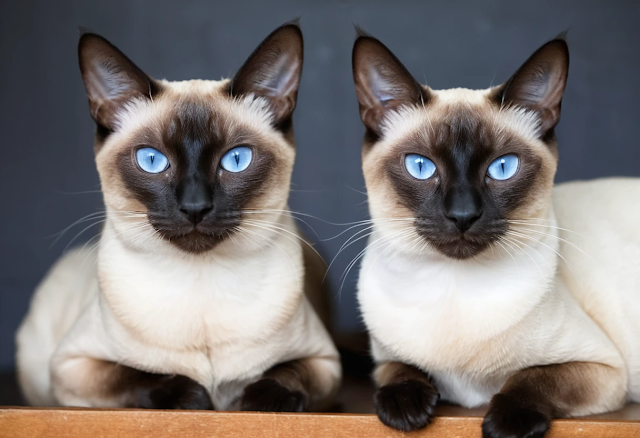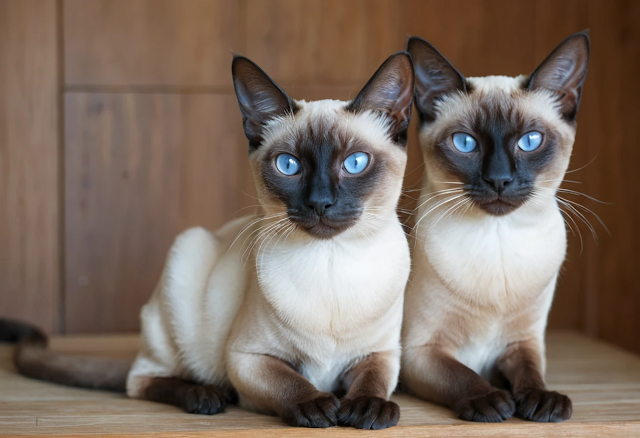Siamese Cats: The Chatty and Elegant Feline Companions
Siamese cats are one of the most recognizable and beloved breeds in the feline world. Known for their striking appearance, vocal personalities, and affectionate nature, these cats have captured the hearts of many pet owners. This article delves into the history, characteristics, care requirements, and unique traits of Siamese cats, providing a comprehensive overview for both potential owners and cat enthusiasts alike.
History of Siamese Cats
The Siamese cat breed has a rich history that dates back centuries. Originating in Thailand, formerly known as Siam, these cats were revered by royalty and often depicted in ancient manuscripts and artwork. The breed was first introduced to the Western world in the late 19th century when they were showcased at cat shows in England. Their unique appearance and charming personalities quickly gained popularity, leading to their establishment as a recognized breed.
Siamese cats were initially bred for their striking color points—darker fur on the ears, face, paws, and tail, with a lighter body color. Over time, breeders began to develop different variations of the breed, including the traditional and modern Siamese, each with distinct features. The traditional Siamese is characterized by a more rounded head and a stockier build, while the modern Siamese has a slender body and a more angular face.
Physical Characteristics
Siamese cats are known for their elegant and athletic build. They typically weigh between 8 to 15 pounds, with males being larger than females. Their bodies are long and slender, with a graceful neck and long legs. One of the most distinctive features of Siamese cats is their striking blue almond-shaped eyes, which are a result of a genetic mutation affecting their pigmentation.
The coat of a Siamese cat is short, fine, and glossy, requiring minimal grooming. The breed is known for its unique color-point pattern, which means that their extremities—ears, face, paws, and tail—are darker than the rest of their body. The most common color points include seal (dark brown), chocolate, blue, and lilac, but there are also variations such as red, cream, and tortie.
Personality Traits
Siamese cats are often described as "chatty" due to their vocal nature. They are known to communicate with their owners through a variety of sounds, including meows, chirps, and trills. This vocalization is not just for attention; Siamese cats are intelligent and social creatures that thrive on interaction with their human companions.
In addition to their vocal tendencies, Siamese cats are highly affectionate and form strong bonds with their owners. They are known to follow their humans around the house, seeking companionship and attention. This breed is also playful and curious, often engaging in interactive play and exploring their environment.
Siamese cats are also known for their intelligence. They can be trained to perform tricks, use a litter box, and even walk on a leash. Their inquisitive nature means they enjoy puzzle toys and games that challenge their minds. However, it is essential to provide them with mental stimulation to prevent boredom, which can lead to destructive behavior.
Care Requirements
Caring for a Siamese cat involves meeting their physical, emotional, and mental needs. Here are some essential aspects of Siamese cat care:
Nutrition
A balanced diet is crucial for maintaining the health of a Siamese cat. High-quality commercial cat food that meets their nutritional needs is recommended. It is essential to choose a diet appropriate for their age, weight, and activity level. Siamese cats can be prone to obesity, so portion control and regular feeding schedules are important.
Grooming
Siamese cats have short, fine coats that require minimal grooming. Regular brushing can help reduce shedding and keep their coat healthy. Bathing is generally not necessary unless they get into something dirty. Regular dental care, including brushing their teeth and providing dental treats, is also important for their overall health.
Health Care
Routine veterinary check-ups are essential for Siamese cats to monitor their health and catch any potential issues early. Siamese cats are generally healthy, but they can be prone to certain genetic conditions, such as respiratory issues and dental problems. Vaccinations, parasite prevention, and spaying or neutering are also crucial components of their health care.
Environment
Siamese cats thrive in a stimulating environment. Providing them with scratching posts, climbing trees, and interactive toys can help keep them entertained. They enjoy being part of the family and should not be left alone for long periods. If you work long hours, consider adopting a second cat to keep your Siamese company.
Socialization
Socialization is vital for Siamese cats, especially during their kitten stage. Exposing them to various people, pets, and environments can help them develop into well-adjusted adults. Positive reinforcement training can also enhance their social skills and strengthen the bond between you and your cat.
Common Health Issues
While Siamese cats are generally healthy, they can be predisposed to certain health issues. Some common conditions include:
Respiratory Problems: Due to their unique facial structure, Siamese cats can be prone to respiratory issues, including asthma and bronchial problems.
Dental Issues: Siamese cats are at a higher risk for dental problems, including periodontal disease. Regular dental care is essential to prevent these issues.
Heart Disease: Hypertrophic cardiomyopathy (HCM) is a genetic condition that affects the heart muscle and can lead to heart failure. Regular veterinary check-ups can help monitor heart health.
Siamese Syndrome: This is a condition that can affect Siamese kittens, leading to neurological issues and developmental delays. It is essential to work with a reputable breeder to minimize the risk of genetic disorders.
Training and Enrichment
Training a Siamese cat can be a rewarding experience due to their intelligence and eagerness to please. Here are some tips for effective training:
Positive Reinforcement: Use treats, praise, and playtime as rewards for good behavior. This encourages your Siamese to repeat the desired actions.
Short Sessions: Keep training sessions short and engaging to maintain your cat's interest. Aim for 5-10 minute sessions a few times a day.
Consistency: Be consistent with commands and routines. This helps your Siamese understand what is expected of them.
Interactive Play: Incorporate interactive toys and games into your training to keep your Siamese mentally stimulated and physically active.
The Siamese Cat in Popular Culture
Siamese cats have made a significant impact on popular culture, appearing in various films, television shows, and literature. One of the most famous portrayals is in Disney's animated classic "Lady and the Tramp," where the mischievous Siamese cats sing the iconic song "We Are Siamese." This portrayal has contributed to the breed's popularity and recognition.
In addition to film, Siamese cats have been featured in numerous books and stories, often depicted as intelligent and cunning companions. Their striking appearance and unique personalities have made them a favorite among authors and artists alike.
Siamese cats are truly remarkable companions, known for their elegance, vocal nature, and affectionate personalities. With a rich history and distinct characteristics, they have earned their place as one of the most beloved cat breeds worldwide. Potential owners should be prepared to meet their physical, emotional, and mental needs to ensure a happy and healthy life for their Siamese cat.
Whether you are considering adopting a Siamese or simply want to learn more about this enchanting breed, understanding their unique traits and care requirements is essential. With proper care, socialization, and training, Siamese cats can bring joy, companionship, and a touch of elegance to any home.
.jpg)











